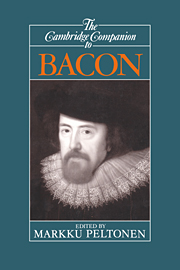Book contents
- Frontmatter
- Introduction
- 1 Bacon's idea of science
- 2 Bacon's classification of knowledge
- 3 Bacon's method of science
- 4 Bacon's forms and the maker's knowledge tradition
- 5 Bacon's speculative philosophy
- 6 Bacon as an advocate for cooperative scientific research
- 7 Bacon's science and religion
- 8 Bacon and rhetoric
- 9 Bacon and history
- 10 Bacon's moral philosophy
- 11 Bacon's political philosophy
- 12 Bacon's legacy
- Bibliography
- Index
12 - Bacon's legacy
Published online by Cambridge University Press: 28 May 2006
- Frontmatter
- Introduction
- 1 Bacon's idea of science
- 2 Bacon's classification of knowledge
- 3 Bacon's method of science
- 4 Bacon's forms and the maker's knowledge tradition
- 5 Bacon's speculative philosophy
- 6 Bacon as an advocate for cooperative scientific research
- 7 Bacon's science and religion
- 8 Bacon and rhetoric
- 9 Bacon and history
- 10 Bacon's moral philosophy
- 11 Bacon's political philosophy
- 12 Bacon's legacy
- Bibliography
- Index
Summary
Posterity has been remarkably generous to Bacon. Yet this generosity has taken the form of a protracted debate and has been largely disguised under the cloak of a culturally tacit certitude. We are faced with that debate from the very moment we are intent to gauge Bacon's technical influence on the ensuing philosophical reflection and in particular in that field in which Bacon is most commonly remembered, namely the epistemological discussion which fills so large a period of Western speculation in the modern age. It is not for nothing that Bacon hails his own Novum organum as a new logic and saw himself as a legislator and discoverer of sorts. But, as will be shown, the exact tenor and merit of Bacon's purported discoveries is open to much dispute. Unshakably certain, on the other hand, is that the ethos he infused into modern science as something inherently related to social development remains by and large a substantial part of our categorial framework.
- Type
- Chapter
- Information
- The Cambridge Companion to Bacon , pp. 311 - 334Publisher: Cambridge University PressPrint publication year: 1996
- 17
- Cited by

